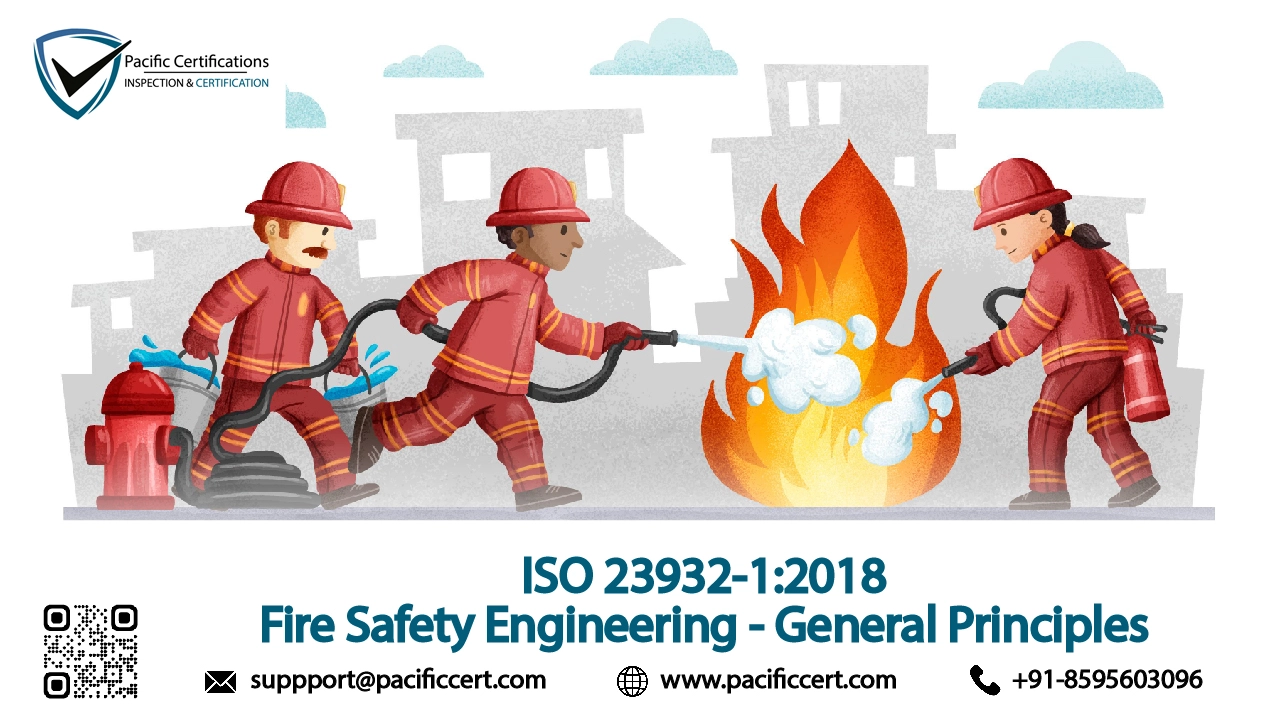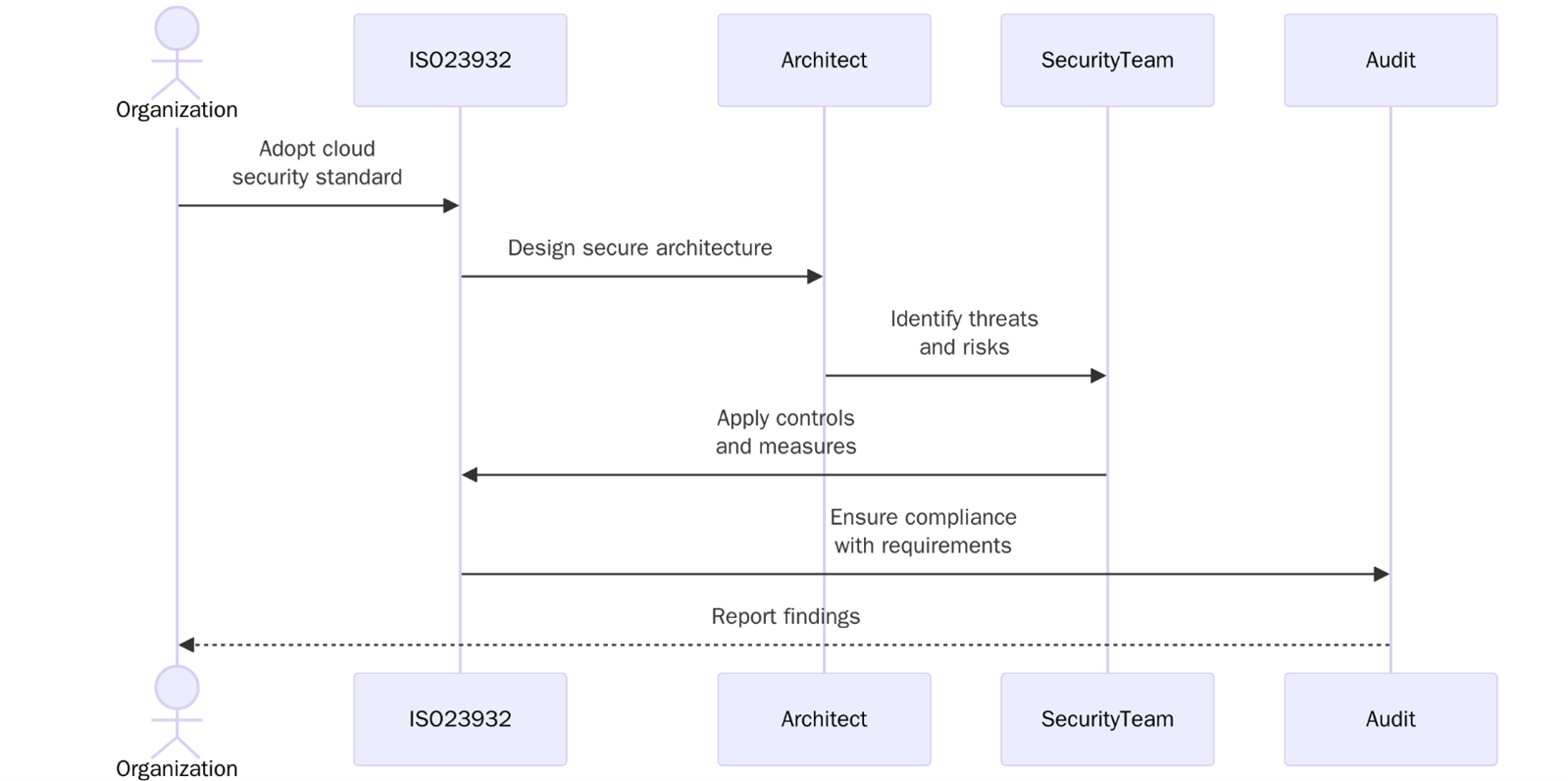What is ISO 23932-1:2018?

ISO 23932-1:2018 sets the international framework for applying fire safety engineering (FSE) principles in the design, assessment, and verification of safety measures in buildings, infrastructure, and industrial facilities. Unlike purely prescriptive codes, it enables performance-based solutions tailored to the unique characteristics of each project.
It provides a systematic method to identify fire hazards, develop scenarios, set safety objectives, and validate the effectiveness of protection strategies through engineering calculations, modelling, and testing. This standard is widely adopted in industries where safety cannot be left to generic guidelines — for example, high-rise construction, petrochemicals, transportation infrastructure, and heritage preservation.
To learn how your organisation can implement ISO 23932-1:2018 principles and align them with certifiable safety standards, contact support@pacificcert.com.
What is the Purpose of ISO 23932?

The purpose of ISO 23932-1:2018 is to give professionals a structured process for evaluating and managing fire safety through performance-based approaches. Traditional codes often dictate fixed measures, which may not suit innovative architectural designs, large industrial processes, or complex public facilities.
This standard ensures fire safety strategies are based on quantitative risk assessment, scientific understanding of fire behaviour, and practical performance objectives. It encourages engineers, architects, and safety regulators to move beyond checklists, instead designing bespoke protection systems backed by evidence.
By following ISO 23932-1:2018, organisations can justify their fire protection measures with data, balance safety with cost efficiency, and accommodate design freedom without compromising life safety or property protection.
Scope and Applicability
ISO 23932 applies to all buildings and infrastructure where fire safety engineering is used to achieve safety objectives. It covers both new constructions and modifications to existing structures, including high-rise buildings, large assembly venues, transportation hubs, industrial facilities, and specialized environments like tunnels or offshore platforms. The standard can be applied in jurisdictions where performance-based design is accepted and is relevant to engineers, architects, fire safety authorities, and building owners. It is particularly valuable in projects where prescriptive codes limit innovation or fail to account for unique fire safety challenges. Additionally, it applies in retrofit situations where balancing heritage conservation with fire safety compliance requires a performance-driven approach.
Key Definitions
- Fire Safety Engineering (FSE): Application of engineering principles to protect life, property, and the environment from the impact of fire.
- Performance-Based Design: Customised fire safety measures designed to meet defined performance criteria rather than prescriptive rules.
- Fire Scenario: A detailed description of conditions and events in a possible fire incident, used for analysis and design.
ISO 23932-1:2018 Clause-wise structure
Title | Description |
Scope | Defines where and how the standard applies in fire safety engineering. |
Normative References | Lists related ISO standards and fire test methodologies. |
Terms and Definitions | Establishes the terminology used throughout the standard. |
Principles of Fire Safety Engineering | Explains the core FSE concepts, including safety objectives and performance verification. |
Fire Safety Engineering Process | Describes steps from hazard identification to final verification. |
Fire Scenarios and Design Fires | Guides the selection of representative fire cases for analysis. |
Evaluation of Safety Measures | Methods for assessing both active and passive fire protection systems. |
Verification and Documentation | Details requirements for demonstrating performance compliance. |
Interaction with Regulations | Advises on integrating FSE with local building codes and regulations. |
What are the requirements of ISO 23932-1:2018?
Organizations looking to implement ISO 23932-1:2018 must meet several key requirements to ensure the proper design and installation of fire safety systems. Below are some of the key requirements:

- Prior to implementing fire safety systems, an overreaching fire risk assessment must be conducted to evaluate potential hazards and their impact on the building and its occupants.
- Establish clear and measurable performance objectives for fire safety. These objectives guide the design process and ensure that fire protection systems meet the specific needs of the building.
- Design fire safety systems based on the results of the risk assessment and in alignment with performance objectives. This may include both passive measures (e.g., fire-resistant materials) and active systems (e.g., sprinklers, fire alarms).
- Fire safety systems must be integrated with other building management systems (e.g., heating, ventilation, and air conditioning) to ensure they function effectively in an emergency.
- Ensure that the design and implementation of fire safety measures comply with local fire safety regulations and building codes.
- Fire safety systems must be tested and verified to ensure they perform as intended. This includes both initial testing and periodic re-assessments.
To integrate ISO 23932-1:2018 principles into your safety framework, contact support@pacificcert.com.
What are the benefits of ISO 23932?
Implementing ISO 23932-1:2018 provides a range of benefits for organizations looking to improve their fire safety practices. Below are some of the key benefits:

- By focusing on performance-based design, ISO 23932-1:2018 allows for more tailored fire safety solutions that meet the specific needs of a building and its occupants.
- The standard provides a structured approach to identifying and managing fire risks, reducing the likelihood of fire-related incidents and damage.
- ISO 23932-1:2018 helps organizations meet international fire safety standards and regulations, supporting regulatory compliance.
- By implementing ISO 23932-1:2018, organizations can show their commitment to fire safety and reduce the risk of reputational damage from fire-related incidents.
- Fire safety engineering aligned with international standards can result in more favourable insurance terms due to reduced risks.
- The performance-based approach encourages smooth use of resources, resulting in cost savings over traditional prescriptive fire safety designs.
The global construction industry is increasingly focused on implementing safety standards that go beyond compliance with basic regulations. Fire safety engineering has become a crucial part of this movement, with many countries adopting more stringent building codes and safety regulations. There is a growing shift towards performance-based fire safety designs, as they allow for more flexible and effective solutions that can be customized to meet the unique risks associated with different buildings and industries.
What is the Certification Process for ISO 23932?
Although ISO 23932-1:2018 itself is not certifiable, it is crucial for organizations to follow the standard’s principles to integrate fire safety engineering into their projects. The following steps outline the process of aligning with the principles of ISO 23932-1:2018:
- Organizations should begin by assessing their current fire safety systems and practices to identify areas where ISO 23932-1:2018 principles can be incorporated. This step involves comparing existing procedures with the standard’s requirements and identifying any gaps.
- A thorough fire risk assessment is essential. This process involves identifying potential fire hazards, evaluating their risks, and determining the necessary fire safety measures based on the building’s usage, structure, and location.
- Based on the results of the risk assessment, organizations should design fire safety systems that align with ISO 23932-1:2018. These systems should include both passive and active fire protection measures.
- Fire safety systems should be integrated with existing management systems (such as ISO 9001 or ISO 14001) to ensure smooth operation and compliance with other quality and environmental management frameworks.
- Fire safety systems should be tested and verified, both during installation and periodically afterward, to ensure that they function as expected in a real fire emergency.
- Once the systems are implemented, regular monitoring and reassessment of fire safety measures are necessary to ensure continued compliance with ISO 23932-1:2018 and to address any new risks.
What are the Certification Costs of ISO 23932?
The cost of implementing ISO 23932-1:2018 principles will depend on the scale of the building and the complexity of the fire safety systems. Although the standard itself is not certifiable, costs associated with implementation include conducting fire risk assessments, designing and installing fire safety systems, and verifying system performance. Third-party audits for Type I and Type III systems will also involve additional costs for testing and certification. Training staff and purchasing any necessary software tools or systems to monitor fire safety will also contribute to the overall cost.
What is Certification Timeline of ISO 23932?
The timeline for implementing fire safety engineering based on ISO 23932-1:2018 principles can vary depending on the scale and complexity of the project. Generally, the entire process can take anywhere from 3 to 6 months. Initially, the first phase involves conducting a fire risk assessment, which may take 1 to 2 months depending on the size of the building and the thoroughness of the evaluation. Once the assessment is complete, designing and integrating fire safety systems based on the findings can take another 2 to 3 months. Finally, the verification and testing of fire safety systems to ensure that they perform effectively may take 1 to 2 months. The overall timeline can fluctuate depending on the complexity of the building design and any potential changes during the process.
Training and Courses
Training in ISO 23932-1:2018 equips engineers, architects, and safety officers with the skills to apply fire safety engineering principles effectively. Common courses include:
- Lead Auditor Training – For professionals involved in auditing integrated safety management systems.
- Lead Implementer Training– For project managers and engineers implementing FSE frameworks.
- Internal Auditor Training – For in-house teams to maintain ongoing compliance and readiness.
Pacific Certifications provides accredited training programmes. If your organisation is looking for ISO 23932-1:2018 training, our team is equipped to help. Contact us at support@pacificcert.com.
How Pacific Certifications Can Help?
Pacific Certifications supports organisations in aligning their fire safety engineering practices with ISO 23932-1:2018. While the standard itself is not directly certifiable, we integrate its principles into audits for related standards.
Our services include:
- Gap assessments for FSE compliance
- Preparation for ISO 9001 and ISO 45001 certification audits
- Technical review of safety strategies and performance criteria
- Advisory on documentation for verification
To align your fire safety engineering practices with ISO 23932-1:2018, contact support@pacificcert.com.
FAQs
Is ISO 23932-1:2018 mandatory?
No, but it is widely accepted as best practice for performance-based fire safety engineering.
Can it replace national fire codes?
It complements them, particularly in jurisdictions allowing performance-based solutions.
What industries benefit most from this standard?
High-rise construction, petrochemicals, transportation, and heritage restoration.
Does it require specialised software?
Yes, for accurate fire modelling and risk analysis, advanced simulation tools are recommended.
Can it be integrated with ISO 9001?
Yes, especially for organisations seeking formal quality management alignment.
What does ISO 23932-1:2018 cover?
It lays out the general principles of fire safety engineering (FSE) for performance-based fire safety design, plus how to implement design plans and manage fire safety in operation. It’s aimed at professionals responsible for PBD projects and ongoing fire safety management.
Ready to get ISO 23932 certified?
Contact Pacific Certifications to begin your certification journey today!
Suggested Certifications –
Read more: Pacific Blogs






